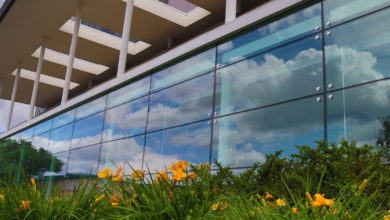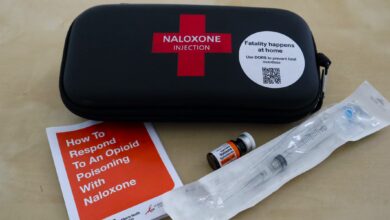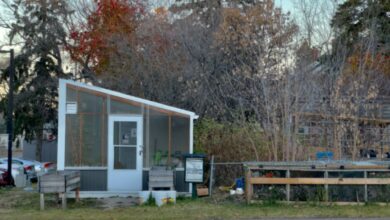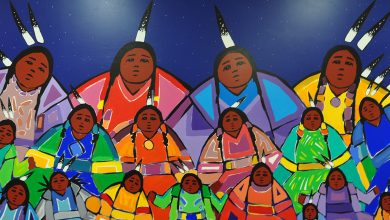First Peoples’ House student meals: More than just stew and bannock
At First Peoples' House, Indigenous students are connecting over hot meals every month.
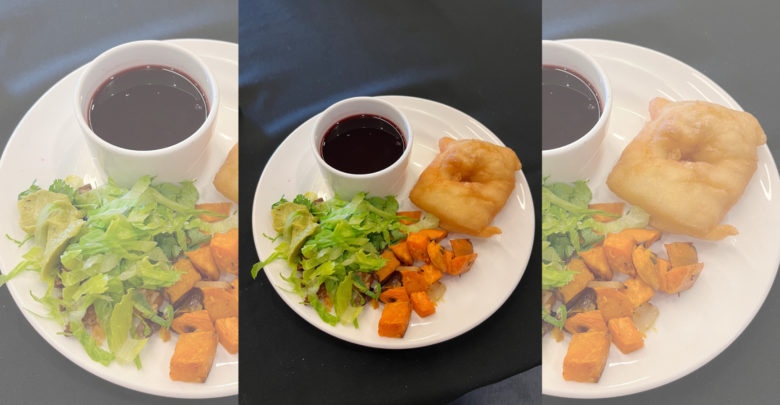 Katie Teeling
Katie Teeling What may appear as just a free lunch, is actually allowing Indigenous students to organically form kinships and connect with the First Peoples’ House community — one plate at a time.
The First Peoples’ House is located in the Students’ Unions Building, and is a space for any and all self declaring First Nations, Métis and Inuit (FNMI) students. They provide many services like counseling and academic support, printing and computer services, a prayer room, and so much more.
Shana Dion is a nehiyaw iskwew (Cree woman) from Kehewin Cree Nation, as well as the assistant dean of FNMI students. Since 2009, her team at First Peoples’ House has served countless Indigenous students here on campus. What once started as a “snack-on-the-go program” has transformed into an initiative to create a space where students can sit down, connect with others, and enjoy a hot meal.
“When you serve food, people gather,” Dion said. “When the students come together, they start to recognize maybe where others are from and kinships happen and relationships happen in a way that is quite beautiful.”
The monthly student meals happen throughout the school year, typically at the beginning of the month, at the First Peoples’ House. All FNMI students at the University of Alberta are welcome to join for lunch time, which serves a variety of meals from good old stew and bannock, to KFC and bannock tacos.
Everyone loves free food. But in reality, there is a lot more going on with the student meals than meets the eye.
Food plays a significant role in many cultures, whether that be at family dinners, events, celebrations, or even weddings. Often, we find some of our fondest memories with others revolving around a plate.
Dion reflected on her experience growing up in Cree culture, and the relationship she had with her Kokum (grandmother).
“Every time you walk into your Kokum’s house, she would always ask if you were hungry, and even if you weren’t hungry — like you just ate, right?” she said. “There was always food.”
Dion took these ideas from her own experience and used them as a framework for developing the programs we see today.
As a first year Métis student here at the U of A, there was a lot for me to get used to. Moving to a city is hard enough when you’re 17, but losing that connection of culture and family makes it harder. When I found First Peoples’ House, I knew instantly that this was going to be my safe haven in all the madness of the university experience.
When you walk into First Peoples’ House, you are greeted with the smell of sage, traditional artwork, and a team of friendly staff to help accommodate you in all your needs. There are places to sit and rest, round tables to gather at, computers to do work, tea and coffee — you name it, it’s there.
In the center of the main room sits a table with fresh fruit and sandwiches. These are part of Dion’s “snacks-on-the-go program,” which was created back in 2009.
“I really wanted our students to feel welcome and when [they] came in, [that] there would be fruit available to them as they walked through the door. So, we’re never asking them, ‘are you hungry?’ cause that’s a hard question to ask a student,” Dion said. “It’s more. Here’s food. If you’re hungry, serve yourself.”
All of these aspects help to create the environment at First Peoples’ House. Showing, not just telling students, that the staff care and are here to welcome them in for whatever they might need.
“A part of connection and relationship and ensuring that our students know that this is a safe space for them and that relationship is really, really key.” Dion said. “This is always the intentional piece, bringing students together in a way as organically as possible,”
At the student meals, you feel this sense of greater connection to those around you. Even though you’re in a room full of strangers, if you sit yourself down at a table and listen to those around you, quickly you find commonalities.
“Somebody could be sitting across the table from you and all of a sudden, it’s like, ‘Oh, where are you from? I’m from Saskatchewan. Oh, which part of Saskatchewan? Oh my God, I think I grew up with you! I think we went to school together.’”
While I didn’t find any long lost friends or relatives, I was able to make connections with students and alumni from various faculties. As Dion says best: you form “kinship ties that may not happen as you’re walking around this vast campus.”
One of the most interesting things that stood out to me during my conversation with Dion was this idea of shared responsibility, but what exactly does that mean?
Shared responsibility is different to everyone. To an elder, they might feel it’s their responsibility to share their teachings and connect with the younger generation. While to someone like myself, I feel it’s important for me to listen and absorb these teachings as it will be my role to teach others.
In the context of truth and reconciliation, it is important to remember that so much culture was lost. Not only that, but lots of trauma was formed. It’s easy to blame people for what has already happened. Whether or not justice has been served is another question. But in order to create strong Indigenous leaders of tomorrow, we have to address the issues that face Indigenous youth today.
Will a hot meal fix the entire Indigenous student body’s issues overnight? No, of course not. These, however, are stepping stones. This is a part of First Peoples’ House’s shared responsibility. And as simplistic as these meals might seem, there are a lot of benefits that can be pulled from them.
“It’s everything — it’s the foundation of the language of our ceremony, of our connections and our kinship,” Dion said.
The cultural connection is one of the most important components of the student meals.
“We always start with praying over the food, acknowledging that food is sacred and food is nothing that we should take for granted,” Dion explained. “Having our elders a part of that conversation from the very beginning, you know, bringing us the blessings and sharing.”
It is easy to feel swallowed up by the hustle and bustle of university life. Not to mention that for a lot of students, like myself, it’s your first time really away from home. Culture is something that ties us together and makes us stronger as individuals. Not having that connection often leaves us feeling unfulfilled or lost. So taking the time and having a space to go to, even if it’s just for a hot meal, provides a sense of grounding and healing that we so often lack in our day-to-day lives.
“It’s breaking down those cultural barriers for our students,” Dion said. “[So] they know ultimately that First [Peoples’] House is a safe space for them to come, acknowledge their journey here and to honour their journey here in a way that they might not have if First Peoples’ House wasn’t there.”
First Peoples’ House is filled with passion and culture from Indigenous students and staff from all across Canada. Our journeys are all so very unique with many different circumstances leading us here today. Regardless, we all find ourselves being able to sit down at the beginning of the month and enjoy a hot meal. Finding commonalities and sharing culture provides us with the much-needed medicine that allows us to continue on our journeys through life.
It’s amazing how a bowl of stew and a piece of bannock can bring so many people together. But it’s safe to say that at the end of the day, it’s so much more than that, as Dion reminded me.
“It’s not just a hot meal. It’s bigger than that. It’s relationships. It’s the foundation of our ceremonies and our culture.”

